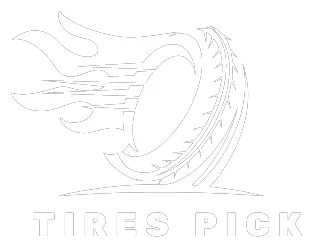We all know that tires are the unsung heroes of our vehicles. They serve as the only contact between our precious cars and the capricious roads. But have you ever wondered about the mysterious numbers and letters etched on their sidewalls? Ever found yourself furrowing your brow at the cryptic “104v” or “104h” on your car’s tire? Well, it’s time to unravel this mystery, folks! We’re about to embark on a journey into the fascinating world of tire codes. Grab your popcorn, sit back, and let’s roll into the deep!
What do 104t, 104s, 104q, 104h, 104r, 104v, 104w mean on a tire?
These alphanumeric combinations are far from random gibberish. They’re actually specific tire load and speed ratings that tell you a whole lot about your tire’s capabilities. You could consider them as your tire’s “vital stats”.
To help you visualize, here’s a handy table outlining these tire markings:
| Load Index | Load per Tire (lbs) | Speed Symbol | Max Speed (mph) |
| 104 | 1984 | T | 118 |
| 104 | 1984 | S | 112 |
| 104 | 1984 | Q | 100 |
| 104 | 1984 | H | 130 |
| 104 | 1984 | R | Not applicable |
| 104 | 1984 | V | 149 |
| 104 | 1984 | W | 168 |
Now, let’s break down these tire codes to understand what each character means.
- 104: This is the tire’s Load Index. It refers to the maximum load that the tire can carry when it’s inflated to its maximum safe pressure. For 104, it’s 1984 lbs.
- T, S, Q, H, R, V, W: These are the Speed Symbols. They indicate the maximum speed at which the tire can carry a load corresponding to its Load Index. Here’s what each letter means:
- T: 118 mph
- S: 112 mph
- Q: 100 mph
- H: 130 mph
- R: Not applicable (R stands for radial construction, not a speed rating)
- V: 149 mph
- W: 168 mph
What does 104T mean on a tire?
Imagine yourself walking into a swanky coffee shop, you’re tired, you need your coffee, and the barista starts firing away with “Would you like a single shot or double shot?” “Do you want steamed milk?” “What about foam?” Well, understanding tire codes can sometimes feel the same. But fret not! Let’s dive deep into what the term “104T” means on a tire, and by the end, you’ll be ordering your tire like a pro!
- 104: As we already established, this is the Load Index. In the case of “104,” the tire can carry a maximum load of 1984 pounds when inflated to its maximum safe pressure. This means it’s built to take on a bit more than your average joe tire, making it ideal for heavier vehicles or those who tend to carry heavier loads.
- T: The “T” here stands for the tire’s Speed Rating. This tire can safely go up to speeds of 118 mph (not that you should be racing on public roads!). So, if you’ve got a bit of a need for speed but also appreciate safety, a 104T tire could be your perfect match.
What does 104S mean on a tire?
Ever found yourself staring at your car’s tires, eyes squinted, utterly baffled by the series of numbers and letters on them? Been there, done that! Today, we’re delving into the perplexing realm of “104S” – a term you might often see on your tire. I promise by the end of this, you’ll be a tire code expert, impressing everyone at the next barbecue party or family gathering.
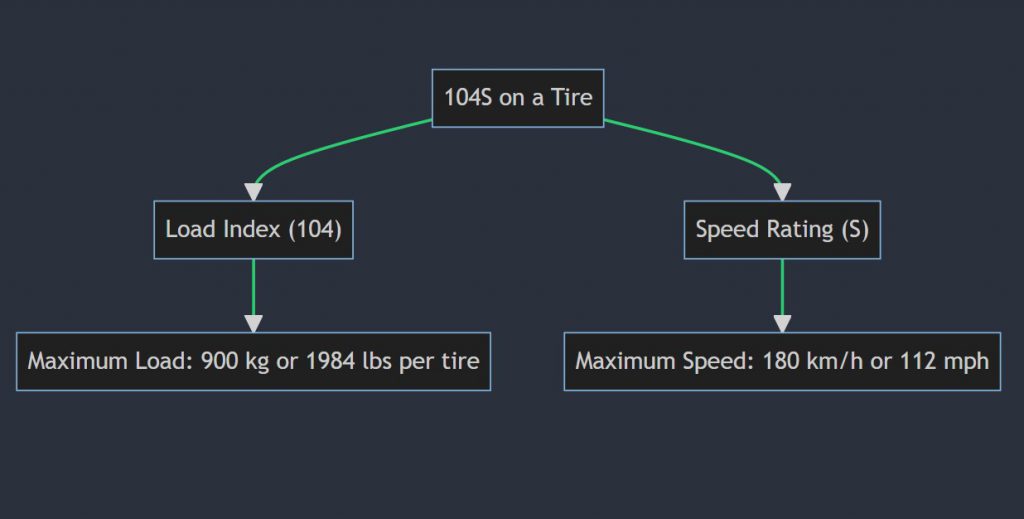
Decoding 104S: A Rollercoaster Ride through the Land of Tire Codes
- 104: This isn’t a random number folks. In tire lingo, this is called the Load Index. This fancy term just means the maximum load the tire can safely carry when it’s inflated to its maximum safe pressure. In this case, 104 equates to 1984 pounds. That’s like carrying a full-grown male Holstein cow or nearly 400 gallons of water. That’s a lot of moos or splashes right there!
- S: Now, the “S” in 104S, is our Speed Symbol. No, it doesn’t mean “Super” or “Speedy Gonzales,” even though that would be fun. This S indicates that this tire can safely roll at speeds up to 112 mph. This is perfect for regular driving conditions where you’re not trying to break the land speed record.
So what can we gather about a 104S tire? It’s like the tortoise from the famous Aesop’s fable, strong and consistent, but it won’t win any races against hare-like sports cars. So, if you’re driving a family sedan, minivan, or a crossover, and you’re not planning on turning every red light into a drag race, the 104S tire might be the perfect fit for you.
What does 104q mean on a tire?
Alright, brace yourself because we’re about to dive into the mysterious world of tire codes once again! This time, we’re cracking the code of “104q” seen on your tire. Hold on to your lug nuts, because this is going to be a wild ride.

Unveiling the Mystery of 104q: The Secret Agent of Tire Codes
- 104: Here we go again with that number. Yes, you guessed it right, it’s the Load Index! With 104, your tire can safely carry a load of 1984 pounds when fully inflated. That’s roughly equivalent to a grand piano or 8 adult male golden retrievers! Talk about being strong and sturdy!
- Q: Q is the Speed Symbol here. It’s like your tire’s secret agent code name. However, unlike James Bond, it’s not licensed to kill, but to roll at a maximum speed of 100 mph. If you’re scratching your head thinking, “Why would I need a tire that can go 100 mph?” Remember, the speed rating is the tire’s maximum safe speed, not a recommended cruising speed.
So what’s the deal with a 104q tire? It’s your reliable buddy, sturdy and perfect for conditions that don’t demand high speeds like city and off-road driving. It’s the Sherlock Holmes of the tire world, strong and steady, and not easily flustered by speed.
What does 104h mean on a tire?
If tire codes were a box of chocolates, “104h” would be that delectable piece that gives you the perfect balance of sweetness and depth. Don’t worry, we’re not about to start chewing on rubber, but rather, we’re about to decode this tire code to help you better understand what you’re dealing with. It’s time for us to be the Sherlock to your Watson and unravel this mystery.
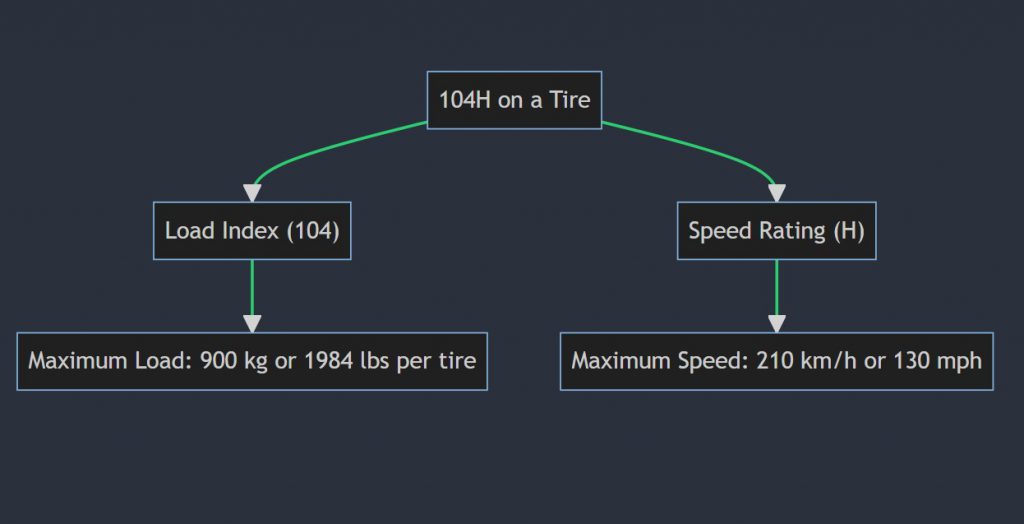
The Delicious Duo of 104h: It’s a Balance, not a Chocolate!
- 104: No, it’s not the temperature of the hottest day of the year. It’s the Load Index of the tire, indicating that it can safely carry a load of 1984 pounds when fully inflated. That’s about the weight of a small car or a pair of grand pianos. Talk about carrying a tune!
- H: The “H” is our Speed Symbol. It’s like a badge of honor your tire wears, telling you that it can safely roll at speeds up to 130 mph. Now, I don’t recommend testing this out unless you’re a professional driver on a controlled track.
So what’s the deal with a 104h tire? It’s perfect for anyone who wants a mix of load-carrying capability and a decent speed rating. Ideal for small to midsize sedans and crossovers.
What does 104r mean on a tire?
Okay, fasten your seatbelts because we’re about to spin into another tire code mystery: the elusive “104r”. It’s not a secret pirate code, it’s just another piece of the tire jigsaw puzzle!
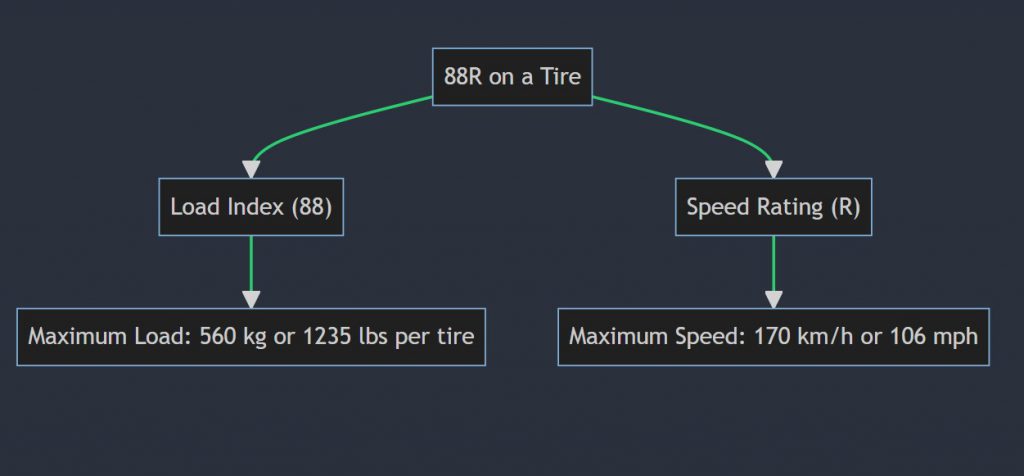
Getting into Gear with 104r: A Whole New Ball Game
- 104: By now, you’re probably screaming, “It’s the Load Index!” And you’re absolutely right! A tire with a load index of 104 can safely carry a load of 1984 pounds.
- R: Here’s where things get a little different. Unlike other codes, the “R” in a tire code doesn’t represent a speed rating. Instead, it denotes Radial construction. This means the tire’s internal ply cords are oriented in a radial direction, from one bead over to the other, 90 degrees to the direction of travel. It’s a popular design thanks to its durability and ride comfort.
The 104r code typically comes into play for truck or SUV tires, designed to carry heavy loads rather than winning any speed trophies. It’s the workhorse of the tire world, always ready to pull its weight!
What does 104v mean on a tire?
Let’s roll into another tire code: “104v”. Now, this one is like the cool kid on the block when it comes to tires. Let’s pop the hood and find out what makes this tire code tick.
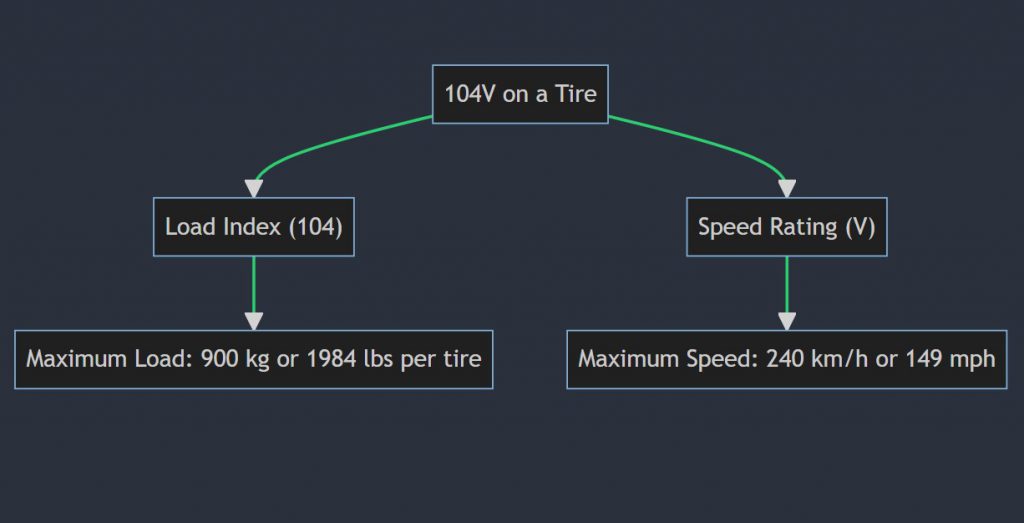
Vrooming into 104v: The Tire Code that Likes to Go Fast
- 104: As our trusty Load Index, it signifies that this tire can safely carry a load of 1984 pounds.
- V: Now, “V” here is our Speed Symbol. This tire can safely go up to speeds of 149 mph. Not that you should be tearing up the streets at this speed, but it’s always nice to know you’ve got the potential!
So, if you have a need for speed and your vehicle is a bit on the heavier side, a 104v tire could be your best companion. Just remember, with great speed comes great responsibility. Drive safe!
What does 104w mean on a tire?
Last but not least, let’s tackle the tire code “104w”. This one is for all you speed demons out there, so hold onto your hats because we’re in for a ride.
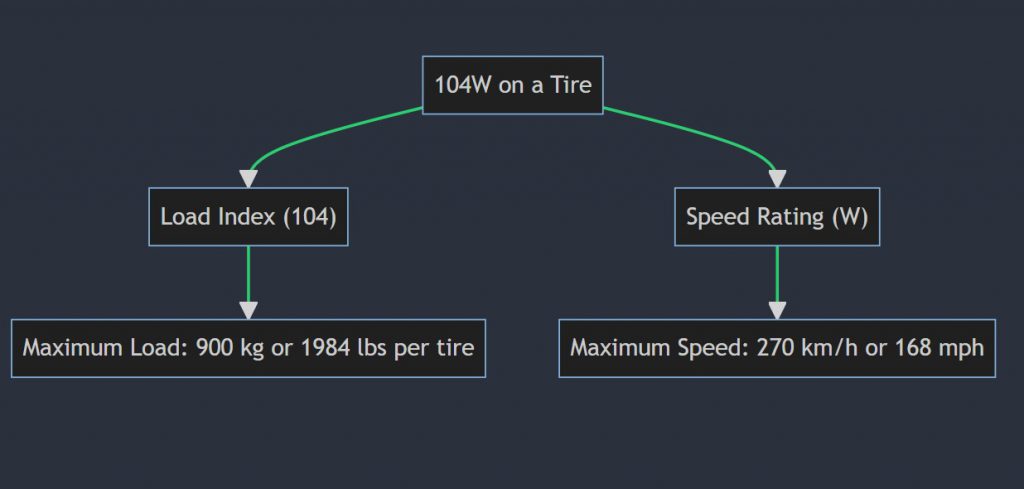
Waltzing with 104w: The High-Speed Dancer
- 104: Our well-known Load Index. Yes, you got it right, it’s 1984 pounds again!
- W: Here we have a speedster. The “W” stands for a whopping maximum safe speed of 168 mph. That’s like keeping up with a peregrine falcon in a dive!
If you have a car that demands high performance and speed, like a sports car or a high-end luxury car, a 104w tire is your ticket to the dance. It offers a great mix of load-carrying capability and a high-speed rating.
Understanding tire codes might feel like trying to understand alien language, but once you get the hang of it, you’ll feel like you’ve cracked the Da Vinci Code. It’s not just about having bragging rights at car meets, it’s also about ensuring your safety and the optimal performance of your vehicle. So, keep these lessons close, drive safer, and let’s roll!
Recap And Summary
To sum up our adventure into the world of tire codes, we learned that these codes aren’t just random alphanumeric characters, but vital pieces of information about your tires. The Load Index (e.g., 104) tells you about the maximum weight your tire can safely carry (1984 lbs in this case). The Speed Rating (like T, S, Q, H, R, V, W) indicates the top speed your tire can safely handle. Remember, driving within safe speed limits ensures optimal tire performance and longevity.
FAQs
Q: 104h vs 104t, what’s the difference?
A: Both have the same load index of 104, meaning they can safely carry 1984 lbs. The difference lies in their speed rating. While H-rated tires can safely handle speeds up to 130 mph, T-rated tires max out at 118 mph.
Q: 104h vs 104v, which one should I choose?
A: Both can handle the same load (1984 lbs). If speed is a priority and your vehicle can handle it, 104v (rated for 149 mph) may be the better choice over 104h (130 mph).
Q: 104h vs 104w, which is faster?
A: 104w is definitely the speedster here, rated for a maximum speed of 168 mph, compared to 104h, which is rated for 130 mph. Again, consider your vehicle’s capability and your driving style.
Q: 104v vs 104w, which tire is better for speed?
A: If speed is your top priority, the 104w, with a speed rating of 168 mph, is the clear winner over the 104v, which is rated for 149 mph.
Q: 104v vs 104t, which one should I go for?
A: Both have the same load index, but the 104v tire has a higher speed rating (149 mph) compared to the 104t tire (118 mph). Choose based on your vehicle’s needs and your driving habits.
Final Verdict
Deciphering tire codes like 104h, 104t, 104s, 104q, 104r, 104v, and 104w may feel like learning a new language, but once mastered, it can make a world of difference in understanding your vehicle’s needs. Knowing these codes isn’t just about impressing your friends at the next car meet; it’s about ensuring your safety on the road. Drive smart, drive safe, and let’s roll!
Alternative Tire Size Codes of Similar Specifications

AR Jeet has been a tire mechanic for over 2years. He has worked on all types of vehicles, from cars and trucks to RVs and ATVs and motorcycles. He has seen it all when it comes to tires, and he knows how to fix them.
AR Jeet is a tire expert, and he is passionate about his work. He loves to help people keep their vehicles running smoothly, and he is always happy to answer any questions that people have about their tires.
If you need help with your tires, or if you just want to learn more about them, then AR Jeet is the man to talk to. He will be happy to help you out, and he will make sure that you get the best possible solution.
He has a blog [Tirespick.com] where he writes about all things tire-related, and he is always happy to help people with their tire needs. Know more about AR Jeet.
